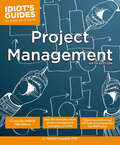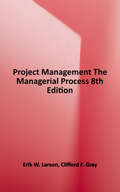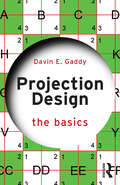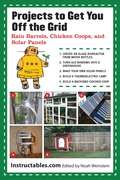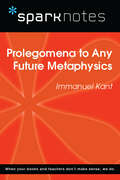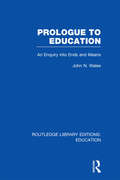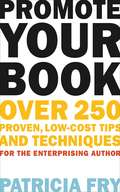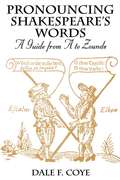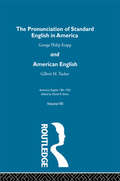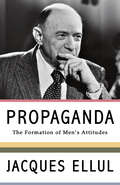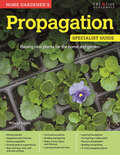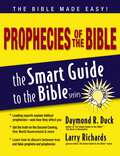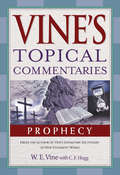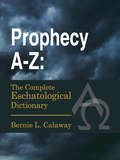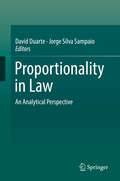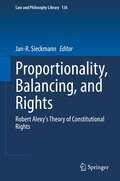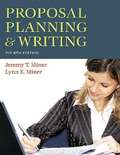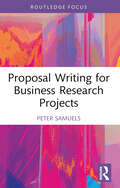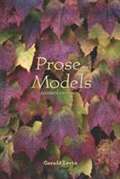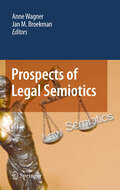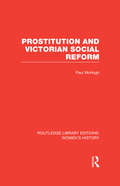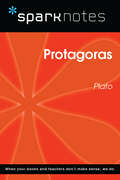- Table View
- List View
Project Management, Sixth Edition (Idiot's Guides)
by G. Michael CampbellSuccessful project management requires organization, skill, and a systematic approach to ensure that projects are delivered on time and on budget. For both small and large organizations, Idiot's Guides: Project Management, Sixth Edition, is fully updated and includes coverage on the Fifth Edition of PMBOK (Project Management Body of Knowledge). Covering all of the latest methodologies, this new, step-by-step edition includes updated assessment questions for the PMP certification exam and content that aligns with the knowledge areas as the PMI (Project Management Institute) defines them.
Project Management: The Managerial Process, 8th Edition
by Erik W. Larson Clifford F. Gray"Our motivation in writing this text continues to be to provide a realistic, socio-technical view of project management. In the past, textbooks on project management focused almost exclusively on the tools and processes used to manage projects and not the human dimension"- Provided by publisher.
Projection Design: The Basics (The Basics)
by Davin E. GaddyProjection Design: The Basics explores the concepts of visual elements in live entertainment. It provides a conversational view of the fundamentals of projection design, from production meetings and the elements of visual design to the equipment necessary to make it all happen.This text examines the themes and theories universal to a wide range of topics, to provide a foundation for anyone interested in using video for their live production or those who are looking where to start as a designer. Topics covered include: Methods of extracting visuals from a script and communicating them to production staff Basics of visual design Understanding human perception and how this influences design How to choose the right equipment to build a system With a detailed glossary, basic formulas, and comprehensive explanation from start to finish, Projection Design: The Basics is an ideal primer for Projection Design courses, and will be of interest to anyone entering the field of projection and media design for the first time.
Projects to Get You Off the Grid: Rain Barrels, Chicken Coops, and Solar Panels
by Instructables. Com Noah WeinsteinInstructables is back with this compact book focused on a series of projects designed to get you thinking creatively about thinking green.<P><P> Twenty Instructables illustrate just how simple it can be to make your own backyard chicken coop, or turn a wine barrel into a rainwater collector.Illustrated with dozens of full-color photographs per project accompanying easy-to-follow instructions, this Instructables collection utilizes the best that the online community has to offer, turning a far-reaching group of people into a mammoth database churning out ideas to make life better, easier, and in this case, greener, as this volume exemplifies.
Prolegomena to Any Future Metaphysics (SparkNotes Philosophy Guide)
by SparkNotesProlegomena to Any Future Metaphysics (SparkNotes Philosophy Guide) Making the reading experience fun! SparkNotes Philosophy Guides are one-stop guides to the great works of philosophy–masterpieces that stand at the foundations of Western thought. Inside each Philosophy Guide you&’ll find insightful overviews of great philosophical works of the Western world.
Prologue to Education: An Inquiry into Ends and Means (Routledge Library Editions: Education)
by John N WalesMany people have come to feel that the controversy on education in Britain has got bogged down in political polemics, and that common polarisations between ‘conventional’ and ‘progressive’, ‘selective’ and ‘comprehensive’, ‘elite’ and ‘democratic’ are both unrealistic and damaging. The author believes that a new educational ethic is needed now that former religious sanctions are no longer generally operative. He believes that it is possible to regard the concept of a Rational Good as a basis for educational theory and practice. The book discusses important practical issues in education: liberty and equality, use and abuse of convention, the ethical basis and occasion for coercion, the validity of co-education as an educational principle and the John Wales concludes that the correspondence between the popular extremes of educational views is much more significant than their differences.
Promote Your Book: Over 250 Proven, Low-Cost Tips and Techniques for the Enterprising Author
by Patricia FryDo you have what it takes to become an author, but are not sure where to start? "Promote Your Book" gives enterprising authors the advantage they need to navigate the publishing industry and gain a better understanding of what book promotion is all about. This well-organized collection of the most successful low-cost and no-cost ideas provides solutions for both aspiring and seasoned authors in any genre. You will learn how to promote the book without changing your lifestyle; how to promote creatively, locally, and through social media; submit news releases and tip sheets; arrange book signings, radio, and TV appearances; enhance marketing skills; spend money in all the right places, and more.
Pronouncing Shakespeare's Words: A Guide from A to Zounds
by Dale F. CoyeA sensible and straightforward guide for students, teachers, and actors of Shakespeare. Based on the results of an extensive survey of 100 Shakespearean scholars and dramatists from the US, Canada, and the UK. Their recommendations on the pronunciation of over 300 controversial words, together with a variety of linguistic studies, are the authorities for the pronunciations given here. Pronunciation variants are listed for the UK, Canada, and the US.
Pronunc Standard Eng America V: and American English
by Daniel R DavisFirst Published in 2003. Routledge is an imprint of Taylor & Francis, an informa company.
Propaganda: The Formation of Men's Attitudes
by Jacques EllulThis seminal study and critique of propaganda from one of the greatest French philosophers of the 20th century is as relevant today as when it was first published in 1962. Taking not only a psychological approach, but a sociological approach as well, Ellul&’s book outlines the taxonomy for propaganda, and ultimately, it&’s destructive nature towards democracy. Drawing from his own experiences fighting for the French resistance against the Vichy regime, Ellul offers a unique insight into the propaganda machine.
Propagating Plants: How to Create New Plants for Free
by Alan ToogoodAre you interested in growing your own plants from scratch? This reference book will teach you how to propagate virtually every type of plant.If you're a thrifty gardener who wants more plants for free, then this book is perfect for you! From fruit trees and ornamental shrubs to exotic orchids and succulents, get all the info you'll need to propagate plants at your fingertips. Discover the experts' secrets to perfecting plant propagation with this easy-to-follow gardening manual. A horticulturist's delight, this new edition features more than 1,800 detailed illustrations and photos that show both practical step-by-step gardening techniques and the plants themselves. How long do your seedlings need to germinate? What makes a healthy stem cutting? How do you know what type of rootstock to use when grafting plants? Find out the answer to these questions and more in the most comprehensive guide to propagating plants ever published.From palms and roses to culinary herbs and conifers, each chapter contains popular and botanically interesting plant groups. Explore the modes of propagation that are unique to the featured plants. Learn about their characteristic ways of reproduction and how these are exploited in various techniques. The techniques are fully illustrated with step-by-step photographs and explanatory artworks. The plants' special needs are discussed, with expert tips on how to achieve success. This gardening book is crammed with hundreds of step-by-step tutorials and clear advice, ranging from straightforward and simple to more in-depth. The rating system in the plant-by-plant A-Z dictionaries provides you with a quick reference to the relative ease or difficulty of each method of propagation.Fill Your Garden with Beautiful Plants for Next-To-NothingPlant propagation is a fun, rewarding and inexpensive way to add shrubs to your garden or multiply your collection of houseplants. This book helps you successfully reach your goals while steering you clear of common mistakes. It's an indispensable reference book for every propagator's bookshelf.Use this comprehensive gardening guide to:Find out how to propagate more than 1,500 garden plants.A-Z dictionaries of different genera of plants, like perennials, vegetables, or bulbous plants.Follow the visual step-by-step guides and authoritative advice on cutting, layering, sowing, grafting, and more.
Propagation: Raising new plants for the home and garden (Home Gardener's)
by David SquireA comprehensive guide to cultivating new plants, from vegetables and flowers to shrubs and succulents, containing techniques for a wide variety of species. Buying individual plants can be expensive—but raising your own saves money and gives lots of gardening satisfaction. Every aspect of the art of propagation is covered, from the philosophy behind creating plants to the easiest species to grow to the best materials and equipment. All the major methods receive well-illustrated, in-depth, and easy to follow explanations, including seeds and cuttings, division and layering, and budding and grafting, and there&’s a handy, at-a-glance A–Z listing of ideal propagation plants for the home and garden. Both novice and more experienced gardeners will turn to this invaluable reference again and again.
Prophecies of the Bible (The Smart Guide to the Bible Series)
by Daymond DuckUnderstand God's Plan-Past, Present, and Future. We're living in tenuous times. Counterfeit doctrines and false prophecies are treated as fact and marketed to the world. Many Christians are confused and disturbed. The Smart Guide to the BibleTM:Prophecies of the Bible gives you the truth about fulfilled and future prophecies. You'll learn how to discern the Sovereign God's many messages-and messengers-as you discover all He has planned for you.
Prophecy (Vine's Topical Commentaries)
by William Edwy VineWilliam Edwy Vine, author of the celebrated Expository Dictionary of New Testament Words, was one of the great evangelical Bible scholars of the twentieth century. He brought to all his writings a level of exegetical care and precision that is rare in any age, ensuring his writings still speak to this generation and future ones. This volume of Vine's Topical Commentaries presents Vine's writings on biblical prophecy, the Second Coming, and last days. The general introduction to the book and specific instructions before each article explain the original context of the writings while demonstrating their significance for today.
Prophecy A-Z: The Complete Eschatological Dictionary
by Bernie L. CalawaySurely you have pondered the future long into the dreary night? No doubt you've wondered how we learned our ethics (or lack of them) and what the future bodes for us buffeted mortals? Are there any more prophets running around loose in or shopping malls or churches? Maybe your neighbor mentioned an eschaton and you're going crazy to know what it means? No? Nevertheless, it's a safe assumption that such matters are alive somewhere in you simply because of your humanity. We want to know things and we intuit that all is not yet done in our universe. But how can we learn and sort it all out? Fear not. Prophecy A-Z has come along (in both first and second editions) to help. As the title implies - it's complete (until the next new word pops up), a dictionary (of prophecy only), and an eschatological data base (look it up). Here is the basic knowledge you need. * A letter-by-letter alphabetic listing of prophetic terms - from Aaron to Zwingli * Sixty essays covering the most complex or fascinating end times concepts * Healthy doses of historical and theological apocalyptic shop talk Take it home and use it. Then, you may want to rush off and try on your God helmet (it's in there between Gochihr and godless myths), or annotate your adiaphora list, or check in on conditions in the zero state .
Proportionality in Law: An Analytical Perspective
by David Duarte Jorge Silva SampaioThis book addresses the principle of proportionality, which is currently one of the most important instruments of judicial review, from both analytical and theory of law perspectives. As such, the analysis provided is far more comprehensive and can be applied to all areas of law, not just constitutional law. On the one hand, the volume offers a broad perspective on several aspects related to proportionality, such as its structure, the balancing methodology and the distinction between rules and principles. On the other, it provides an innovative, normativist and analytical approach to proportionality, helping readers understand its structure and behaviour.
Proportionality, Balancing, and Rights: Robert Alexy's Theory of Constitutional Rights (Law and Philosophy Library #136)
by Jan-R. SieckmannThe book focuses on Robert Alexy’s theory of constitutional rights. Alexy systematically presented the theory in his seminal book “Theorie der Grundrechte” (1985; Engl. translation “Theory of Constitutional Rights, 2002) and continued to develop it in numerous subsequent articles. Arguably still the most influential theory of constitutional rights, it has found widespread academic support, as well as recognition in several constitutional jurisdictions. On the other hand, it has also been the object of considerable criticism. The aim of this book is to outline the central aspects of Alexy’s theory as he sees them, and to further develop the principles of constitutional, fundamental, and human rights by applying a constructive criticism of his theory.
Proposal Planning and Writing
by Jeremy T. Miner Lynn E. MinerGives grant seekers practical advice and numerous examples to assist them in planning and writing proposals, with special attention to the availability of information on the Internet.
Proposal Writing for Business Research Projects (Routledge Focus on Business and Management)
by Peter SamuelsThis book helps students with the initial phases of their business research project, offering a clear step-by-step approach from defining aims and research questions through to conducting literature reviews and writing a methodology. Features to aid learning include chapter objectives, plentiful real-life examples to demonstrate good practice, exercises to apply the concepts and further reading for proactive investigation. A self-contained guide to every stage of writing an effective business research proposal, this text should be recommended reading for all advanced undergraduate and postgraduate students studying Business Research Methods and embarking on a research project of their own.
Proposals That Work: A Guide for Planning Dissertations and Grant Proposals
by Stephen J. Silverman Lawrence F. Locke Waneen Wyrick SpirdusoPrevious editions of this book have helped well over 100,000 students and professionals write effective proposals for dissertations and grants. Covering all aspects of the proposal process, from the most basic questions about form and style to the task of seeking funding, Locke/Spirduso/Silverman’s Proposals That Work offers clear advice backed up with excellent examples. In the fifth edition, the authors have included a discussion of the effects of new technologies and the Internet on the proposal process, with URLs listed where appropriate. In addition, there are new sections covering alternative forms of proposals and dissertations and the role of academic rigor in research. As always, the authors have included a number of specimen proposals, two that are completely new to this edition, to help shed light on the important issues surrounding the writing of proposals. Clear, straightforward, and reader friendly, Proposals That Work is a must own for anyone considering writing a proposal for a thesis, a dissertation, or a grant.
Prose Models (11th Edition)
by Gerald LevinContaining over 110 selections by contemporary and classic writers, PROSE MODELS is a rhetorical reader that covers the major elements of paragraph, essay and methods of development with an emphasis on Argument and Persuasive writing.
Prospects of Legal Semiotics
by Jan M. Broekman Anne WagnerThis book examines the progress to date in the many facets - conceptual, epistemological and methodological - of the field of legal semiotics. It reflects the fulfilment of the promise of legal semiotics when used to explore the law, its processes and interpretation. This study in Legal Semiotics brings together the theory, structure and practise of legal semiotics in an accessible style. The book introduces the concepts of legal semiotics and offers an insight in contemporary and future directions which the semiotics of law is going to take. A theoretical and practical oriented synthesis of the historical, contemporary and most recent ideas pertaining to legal semiotics, the book will be of interest to scholars and researchers in law and social sciences , as well as those who are interested in the interdisciplinary dynamics of law and semiotics.
Prostitution and Victorian Social Reform (Routledge Library Editions: Women's History)
by Paul McHughIn the mid-nineteenth century many parts of England and Wales were still subjected to a system of regulated prostitution which, by identifying and detaining for treatment infected prostitutes, aimed to protect members of the armed forces (94 per cent of whom were forbidden to marry) from venereal diseases. The coercive nature of the Contagious Diseases Acts and the double standard which allowed the continuance of prostitution on the ground that the prostitute 'herself the supreme type of vice, she is ultimately the most efficient guardian of virtue', aroused the ire of many reformers, not only women’s rights campaigners. Paul McHugh analyses the social composition of the different repeal and reform movements – the liberal reformists, the passionate struggle of the charismatic Josephine Butler, the Tory reformers whose achievement was in the improvement of preventative medicine, and finally the Social Purity movement of the 1880s which favoured a coercive approach. This is a fascinating study of ideals and principles in action, of pressure-group strategy, and of individual leaders in the repeal movement’s sixteen year progress to victory. The book was originally publised in 1980.
Protagoras (SparkNotes Philosophy Guide)
by SparkNotesProtagoras (SparkNotes Philosophy Guide) Making the reading experience fun! SparkNotes Philosophy Guides are one-stop guides to the great works of philosophy–masterpieces that stand at the foundations of Western thought. Inside each Philosophy Guide you&’ll find insightful overviews of great philosophical works of the Western world.
Protecting American Health Care Consumers
by Eleanor Dearman KinneyDespite the attention to the problem of protecting the health care interests of Americans, there is little consensus on what should be done politically or otherwise to address this problem. In Protecting American Health Care Consumers Eleanor DeArman Kinney, a nationally regarded expert on health policy and law, tackles the serious and ongoing debate among state and federal policymakers, health care providers, third-party payers, and consumers about how to provide procedural justice to patients in the present health care climate. To promote and ensure consumer protection in an increasingly adversarial and complicated health-care culture, Kinney first analyzes the procedures by which consumer concerns are presently discerned and resolved and then explains why these systems are unsatisfactory. She also discusses problematic procedures for making coverage policy and quality standards and proposes reforms in a variety of processes that would enable all consumers, including the uninsured, to influence key policies and standards and also to raise concerns and obtain appropriate remedies. As the first comprehensive treatment of administrative procedures in American health plans and other such institutions, Protecting American Health Care Consumers will be welcomed by state and federal policymakers, managed care executives, and lawyers charged with designing and implementing protections for consumers in public and private health plans.
